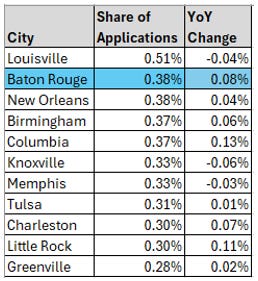The Talent Wars: Positive News from the Front
A greater share of new college graduates across the country are applying to jobs in Baton Rouge – and that share is growing faster than that of our peers
Attracting and retaining talent has been the subject of countless articles, studies, conferences, and more across the globe over the last few years, and understandably so. In late-2023, the professional services firm Aon surveyed 3,000 risk managers, c-suite, and other executives across the globe in order to gauge their respective businesses’ strongest pain-points. “Failure to Attract or Retain Top Talent” came in as the fourth greatest risk, its highest ranking ever. It finished ahead of supply chain issues and regulatory/political changes, and behind economic slowdown and cyberattacks. Louisiana has been particularly vulnerable to this trend, as it experienced net population loss since 2016; while population trends are less dire in the Capital Region, local business leaders cited “lack of qualified talent” as their top obstacle at the end of 2023, higher than inflation, crime, insurance, or traffic1. A recent report, though, provides Baton Rouge with some reason for optimism.
Handshake is the world’s largest student and recent graduate job platform, with more than 15 million students from more than 1,500 colleges and universities that can connect to nearly one million employers. Handshake recently released a report, Catching Up with the Class of 2024, which served as a deep dive into job preferences and applicant behavior for all platform users completing their degrees or programs in 2024. Included in the report is a map that details what share of overall job applications were for jobs in a given city, as well as whether that city’s share of the application pool grew or shrank from the classes of 2023 to 2024.
The map is full of trends that many may find surprising – for instance, the share of new graduates applying for jobs in Austin, Houston, Dallas, Atlanta, Nashville, and Charlotte all fell year-over-year. Among the largest gainers in the country were New York City and Washington DC – cities whose management is often maligned in the media.
Meanwhile, many mid-sized metros in the southeast saw a spike.
This table contains some great news for Baton Rouge businesses and residents. The city’s share of the total applicant pool is equal to the much larger city of New Orleans, and greater than that of larger cities like Memphis and Tulsa. Baton Rouge’s share of applicant growth was also greater than eight of its 10 regional peer cities.
It’s no accident that Baton Rouge is punching above its weight class; it’s likely that part of the increase is based on local talent retention efforts. Starting in 2020, BRAC, Handshake, Capital Region businesses, and our local higher education institutions formed a partnership to ensure college students in our own backyard are aware of job opportunities available in the metro area. The results of these talent retention efforts have been strong, especially at LSU, where two-thirds of students are active on Handshake, including three-fourths of upperclassmen2.
But not only was engagement high generally, it benefited Baton Rouge more than any other metro in the country. Through Handshake, LSU students applied to twice as many jobs in Baton Rouge as they did to New Orleans, Dallas, or New York – and more than Houston, the metro to which the Capital Region generally loses the most talent.
While the Handshake report and other recent data show that the community is making progress in terms of student and new graduate talent, there is still significant work to be done, particularly in terms of attracting and retaining early- and mid-career professionals. As we continue to expand our national talent campaign, Better in BTR, it’s important that we continue to highlight our region’s selling points and victories, while continuing to build communities in which young talent wants to live.
BRAC Economic Outlook Survey, October 2nd-20th, 2023
LSU Handshake data based on applications received between September 1, 2022 and September 1, 2023.







